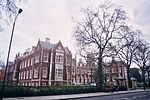Park House, Kensington
Park House, at 7–11 Onslow Square, is a detached house in the South Kensington district of the Royal Borough of Kensington and Chelsea in London SW7. It is set in one acre (4,000 m2) of land and is shielded by trees from public view. Park House was created from a pair of lodges, Pelham Cottage and Park Cottage built in the 1840s that were merged into a single property in the 1980s.The house was owned by Mark Birley who lived there with his wife Annabel Goldsmith. Goldsmith wrote a memoir, No Invitation Required: The Pelham Cottage Years about her time at the house. Goldsmith described her first visit to the house creating a "catch of pure excitement in my throat...I could not believe that such an oasis could exist only a few yards from South Kensington Tube station. In my daze of delight, I knew immediately that I had stumbled upon something magical".The house was sold by the German art historian and industrial heir Gert-Rudolf Flick for £40 million to the businessman Richard Caring in 2017. Flick described Park House as "almost a country house in the middle of London". The house had been on sale for £105 million since September 2013.Caring has submitted proposals to demolish the present house and replace it with an 18,000 sq ft (1,700 m2) six-bedroomed two-storey house with a double-level basement. The new ground floor will have a dining room and a 48 ft (15 m) long drawing room in addition to a family room and a children's study. The planned basement will incorporate a cinema and a 50 ft (15 m) long swimming pool as well as a massage, steam and sauna rooms and a gym. Caring's proposal received 22 letters of objection from local residents. A £235,000 payment for local housing in the Royal Borough of Kensington and Chelsea formed part of the conditions for the council's approval of the plans.
Excerpt from the Wikipedia article Park House, Kensington (License: CC BY-SA 3.0, Authors).Park House, Kensington
Onslow Square, London Brompton (Royal Borough of Kensington and Chelsea)
Geographical coordinates (GPS) Address External links Nearby Places Show on map
Geographical coordinates (GPS)
| Latitude | Longitude |
|---|---|
| N 51.493325 ° | E -0.172231 ° |
Address
Park House
Onslow Square 7-11
SW7 3NN London, Brompton (Royal Borough of Kensington and Chelsea)
England, United Kingdom
Open on Google Maps











